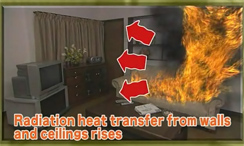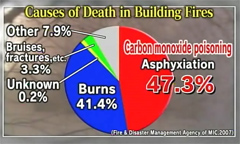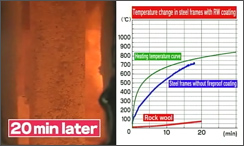
Fire-related Video
Video Program for Fire Science Education
Fire Science Group made the following three Videos for the education of Fire Science. We have both Japanese and English versions.
You can download English versions.
I. Mechanism of Fire - Flashover and Back Draft - (30:01)
Video shows the high-risk of flashover and back draft through many experiments. An experiment shows why the combustion rate in the room is more than that in open space like a garden. Test results by cone calorimeter indicate the flammability and combustion rate of each material. A phenomenon of flashover is explained by the picture and the jump-up of temperature in real size experiment. About the back draft, its mechanism is explained and it is shown the difficulty of prediction when the back draft occur by repeating the experiments.
II. Mechanism of Smoke (25:31)
About half of the death by fire is caused by CO poisoning. The toxicity, the invisibility and the spread speed of the smoke are explained through experimental studies. About the toxicity, the result of FTIR ( the apparatus to analyze the gas component which generates under the condition of low oxygen concentration ) shows that the difference of the materials does not affect on CO generation. But CO generation increases in case that the flammable material ( for example, acrylic plate ) accelerate the combustion. The result of experiment is very interesting that the evacuation time of the strange examinees those get off from the second floor through smoke-filled staircase and smoke-free differs widely.
III. Fire-resistive Construction - Construction Member and Design for Fireproof (26:16)
The experiment shows the collapse mechanism of the building by a fire and the importance of the performance of fire-resistance. The experiments show that the temperature rise by a fire (900属C) reduces the strength of steel column and collapses it, and fire-resistive covering prevents temperature rise and increases the performance of fire-resistance. Reinforced concrete which is low heat conduction has a weak point in explosive fracture, and the countermeasure is introduced in the experiment. It is explained that whether the fire spread to the next floor above or not and whether the junction of beam and column can redistribute the stress or not have a strong effect to the performance of structure.
 Japanese
Japanese


